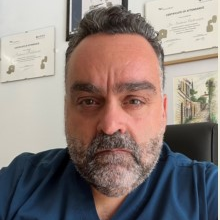A Multidisciplinary Approach in Head and Neck Malignancies
A special issue of Journal of Clinical Medicine (ISSN 2077-0383). This special issue belongs to the section "Oncology".
Deadline for manuscript submissions: closed (30 September 2023) | Viewed by 17814
Special Issue Editors
Interests: glaucoma; general ophthalmology; intraocular pressure; tonometry; mesenchymal stem cell; eyes; visual fields; clinical ophthalmology
Special Issues, Collections and Topics in MDPI journals
Interests: neurosurgery; glioma; meningioma; glioblastoma; brain mapping; real-time neuropsychological testing; brain tractography
Special Issues, Collections and Topics in MDPI journals
Interests: brain tumor; skull base surgery; pituitary tumor; gliomas, meningiomas
Interests: CyberKnife; radiosurgery; SBRT; FSRT; radiotherapy
Special Issues, Collections and Topics in MDPI journals
Interests: maxillofacial surgery; computer-guided surgery; virtual reality; augmented reality; 3D printing; liquid biopsy; maxillofacial oncology; temporomandibular joint; orthognathic surgery
Special Issue Information
Dear Colleagues,
Head and malignancies involve a highly complex anatomical district, in which a multidisciplinary approach is of utmost importance when it comes to clinical management, surgical strategies and adjuvant therapies. Head and neck cancers account for a high number of diagnoses and deaths each year, being the 7th most frequent tumor worldwide. Local therapy with surgery and radiotherapy represent the most effective treatments for these tumors, while systemic chemotherapy tends to be mostly considered in tumor relapse. Current ongoing studies have been providing new insights into the stem cell and molecular mechanisms of these tumors, which may pave the way to novel treatment options in the near future.
New strategies and approaches aim at less invasive techniques, increased radicality and simulation 3D technology. Modern methods tend to consider anatomic variability, virtual 3D reconstruction, and functional restoration. Virtual planning and 3D imaging and printing represent the most important advances in technology in diagnostic and surgical settings. Current literature has shown that these methods are being increasingly applied, providing postoperative clinical success. Computerized preoperative and perioperative planning with precise definition of resection areas and enhanced visualization can contribute to cleaner margins, more effective reconstruction, and greater extent of tumor resection, with the aim of preserving function.
Modern diagnostic approaches are showing substantial progresses, especially in the field of liquid biopsy, allowing to characterize neoplasms from a non-invasive sampling, directly performed on liquid matrices. Molecular and histopathology markers are becoming of great interest in grading severity and providing prognostic factors and scores that can be beneficial in the individual planning and management of patients. Real time continuous perioperative neurophysiological testing, novel staining markers, awake surgery and modern surgical tools have shown benefits in terms of greater extent of resection and survival.
The primary goals of this Special Issue are to provide a collection of pertinent topics and highlight the importance of innovative and multidisciplinary approaches in head and neck malignancies, with regards to novel diagnostic tools, surgical strategies, and adjuvant therapies in managing patients with these lesions.
Dr. Marco Zeppieri
Dr. Tamara Ius
Prof. Dr. Filippo Flavio Angileri
Dr. Antonio Pontoriero
Dr. Alessandro Tel
Guest Editors
Manuscript Submission Information
Manuscripts should be submitted online at www.mdpi.com by registering and logging in to this website. Once you are registered, click here to go to the submission form. Manuscripts can be submitted until the deadline. All submissions that pass pre-check are peer-reviewed. Accepted papers will be published continuously in the journal (as soon as accepted) and will be listed together on the special issue website. Research articles, review articles as well as short communications are invited. For planned papers, a title and short abstract (about 100 words) can be sent to the Editorial Office for announcement on this website.
Submitted manuscripts should not have been published previously, nor be under consideration for publication elsewhere (except conference proceedings papers). All manuscripts are thoroughly refereed through a single-blind peer-review process. A guide for authors and other relevant information for submission of manuscripts is available on the Instructions for Authors page. Journal of Clinical Medicine is an international peer-reviewed open access semimonthly journal published by MDPI.
Please visit the Instructions for Authors page before submitting a manuscript. The Article Processing Charge (APC) for publication in this open access journal is 2600 CHF (Swiss Francs). Submitted papers should be well formatted and use good English. Authors may use MDPI's English editing service prior to publication or during author revisions.
Keywords
- neurosurgery
- maxillofacial surgery
- radiotherapy
- chemotherapy











